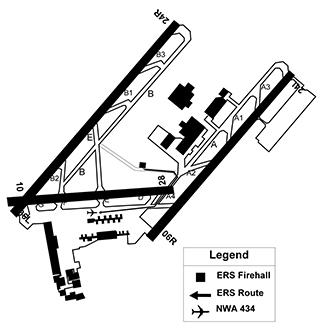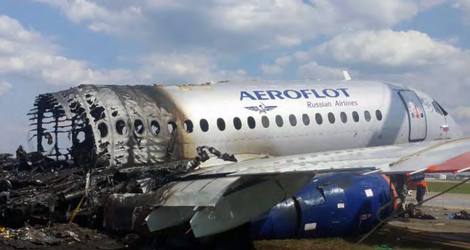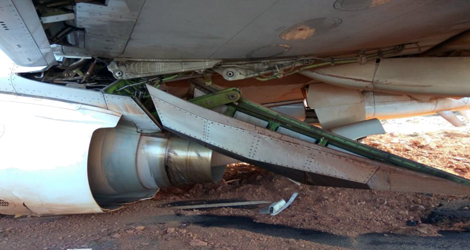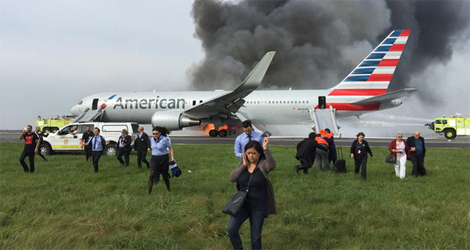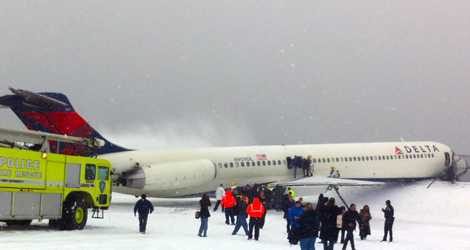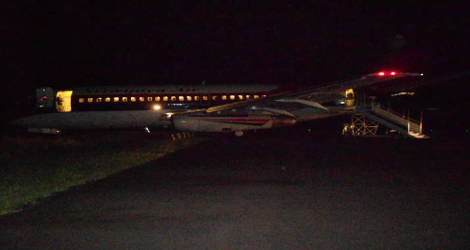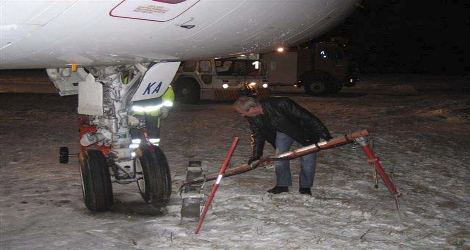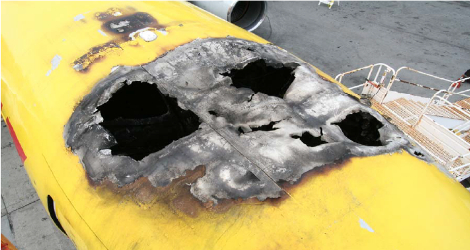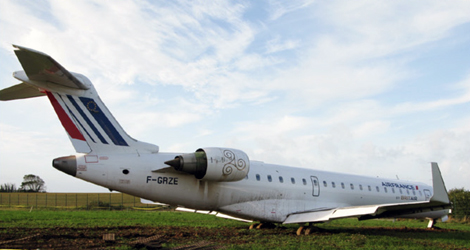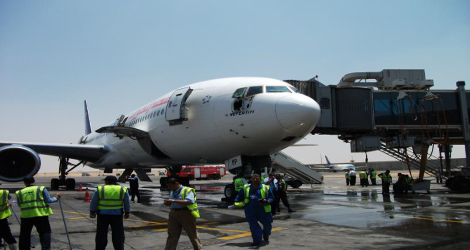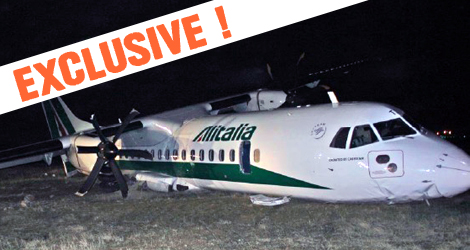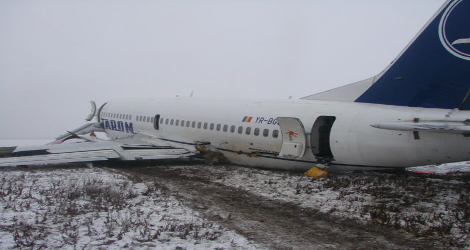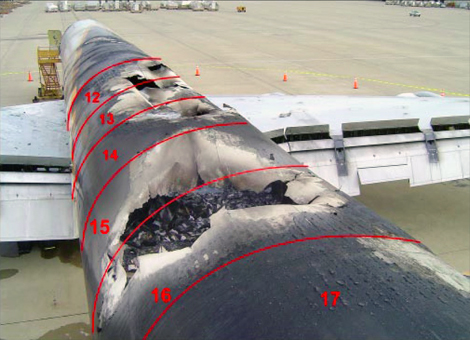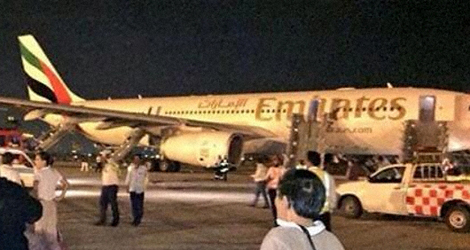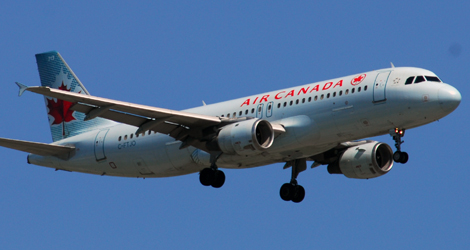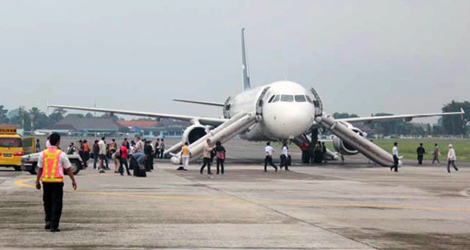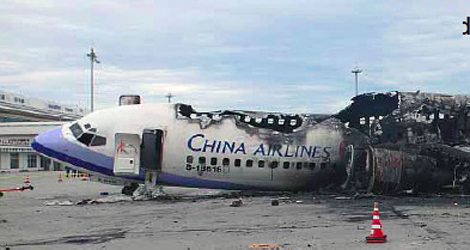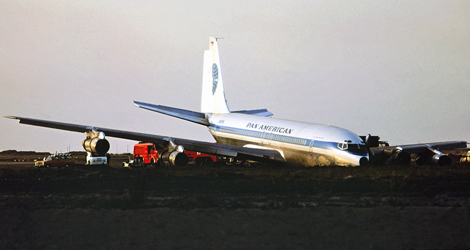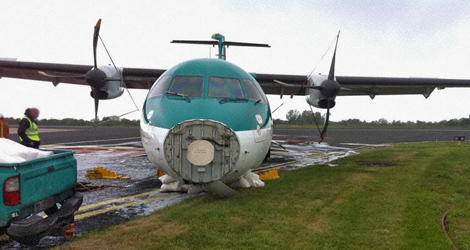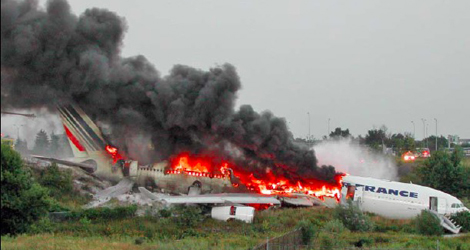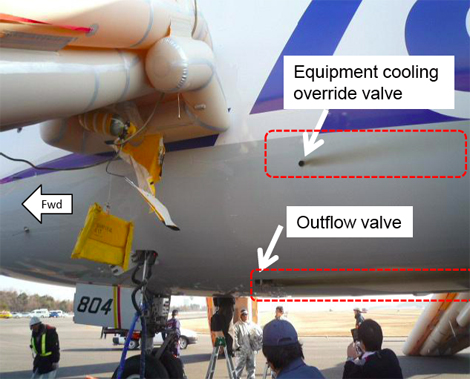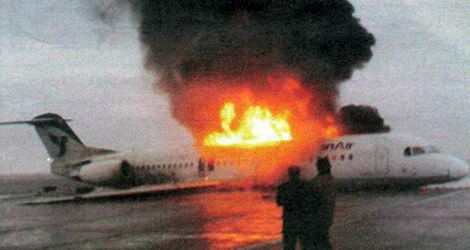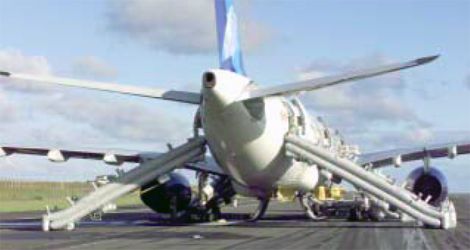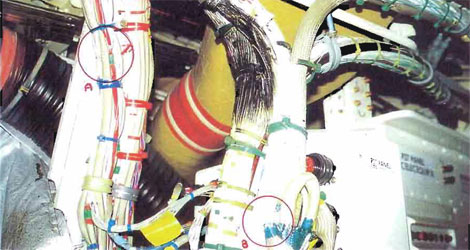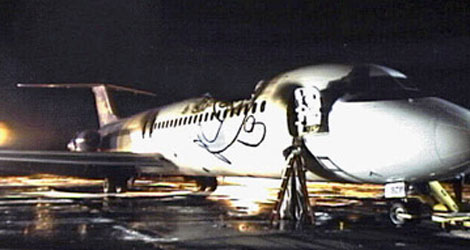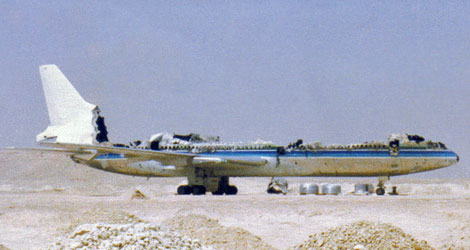Northwest Airlines flight NWA434 was a flight bound to Detroit (Michigan US) on Sunday, 28 November 1993, scheduled at 07:00 eastern standard time (EST). The airplane , a Boeing B727-200 (registered N278US) was was parked at gate 33 at the Montreal International...
Airplane evacuation and certification are two sides of the same coin in ensuring passenger safety. Here’s a breakdown of both:
Aircraft Evacuation:
Emergency Scenarios: Evacuation becomes necessary in various situations like fire, smoke, serious mechanical issues, or even a medical emergency on board.
Focus on Speed: Every aspect is designed for rapid disembarking. Cabin crew, extensively trained in evacuation procedures, guide passengers. Illuminated emergency exits and clear signage lead everyone to the quickest escape route. Inflatable slides deploy from exits over the wings, providing a safe descent to the ground.
Passenger Role: Staying calm and following crew instructions are crucial. Pre-flight safety demonstrations brief passengers, and knowing your nearest exits beforehand is vital.
Certification Process:
Focus on Manufacturer: This is where the 90-second benchmark comes in. To obtain certification for an aircraft model, the manufacturer must demonstrate the airplane’s ability to be completely evacuated within 90 seconds under controlled conditions.
Rigorous Testing: This doesn’t involve actual passengers but uses a specific number of volunteers. Only half of the available exits are used, simulating potential blocked exits due to fire or damage.
Focus on Efficiency: This test ensures the aircraft design, emergency exits, and crew procedures can facilitate a safe and rapid evacuation in real-world emergencies.
Key Points:
The 90-second standard applies to manufacturer certification, not passenger training.
Passengers can enhance preparedness by paying attention to safety briefings and familiarizing themselves with exits.
Both evacuation procedures and certification processes prioritize passenger safety during emergencies.
Emirates Boeing B777-300 (A6-EMW) flight EK521
Emirates flight EK521 crashed on 3 August 2016 while operating a scheduled passenger flight UAE521, departed Trivandrum International Airport India, at 0506 UTC for a 3 hour 30 minute flight to Dubai International Airport (OMDB), the United Arab Emirates, with 282...
Aeroflot Superjet 100 (RA-89098) flight SU1492
Update of Aeroflot superjet 100 flight SU1492 : a preliminary report has been issued today , June 16th 2019 by the Interstate Aviation Committee. According to the preliminary report, the following facts have been proven: airplane hit by lightning during climb...
Jet Airways – Boeing B737-800 (VT-JBG) flight 9W2374
Jet Airways flight 9W2374 was a scheduled flight on December 27th 2016 from Goa, India to Mumbai, operated with a Boeing B737-800 aircraft. The flight was under the command of an ALTP holder with a CPL holder acting as First Officer. In addition to the cockpit crew,...
American Airlines – Boeing B767-300 (N-345AN) flight AA383
American Airlines flight AA383 , from Chicago O'Hare to Miami, FL , operated with a Boeing B767-300 (N-345AN) stopped on the runway during takeoff roll, caught fire and evacuated the passengers. American Airlines flight AA383 had 161 passengers and 9 crew on board,...
Delta Airlines – McDonnell Douglas MD88 (N-909DL) flight DL1086
On March 5, 2015, at 1102 eastern standard time, Delta Airlines flight DL1086 , a Boeing MD-88, N909DL, was landing on runway 13 at LaGuardia Airport (LGA), New York, New York, when it departed the left side of the runway, contacted the airport perimeter fence, and...
Sirwijaya Air – Boeing B737-200 (PK-CJD) flight SJ041
On 24 December 2011, a Boeing 737-200 aircraft, registered PK-CJD, was being operated by PT Sriwijaya Air on a schedule passenger SIRWIJAYA AIR flight SJ041 from Sultan Syarif Kasim II Airport (WIBB) Pekanbaru to Soekarno Hatta Airport (WIII), Jakarta. There were 134...
Mytravel Airways Scandinavia – Airbus A321-211 (OY-VKA) flight VKG866
Mytravel Airways Scandinavia flight VKG866 flew from Tenerife Airport (GCTS) to Sandefjord Airport Torp (ENTO) on 26th of March 2006. The first officer was Pilot Flying (PF) and the commander was Pilot Not Flying (PNF). The crew reviewed updated weather and runway...
ABX AIR – Boeing B767-200 (N799AX) flight ABX1611
On June 28, 2008, about 2215 Pacific daylight time, an Boeing 767-200, registered N799AX, operating as ABX AIR flight ABX1611 from San Francisco International Airport, San Francisco, California, experienced a ground fire before engine startup. The captain and the...
BRIT AIR – Bombardier CRJ700 (F-GRZE) Flight AF5937
The BRIT AIR flight AF5937 crew took off from Paris Orly at 18 h 30 bound for Lorient Lann Bihoué. It was the fifth and last flight of the day. The captain was at the controls (PF). At around 19 h 00 just before the descent, he reviewed the ATIS Whisky information...
Egypt Air – Boeing B777-200 (SU-GBP) flight MS667
On July 29, 2011, a Boeing 777-200, Egyptian registration SU-GBP, operated by EgyptAir, arrived from Madina, Saudi Arabia (Flight No 678) and stopped at Gate F7, terminal 3, Cairo international airport almost at 0500 UTC time. Necessary maintenance actions (After...
Carpatair – ATR72-500 (YR-ATS) flight AZ1670
Alitalia flight AZ1670 operated by Carpatair with ATR72-212A (ATR72-500) registration YR-ATS departed Pisa (LIPR) bound to Rome Fiumicino Airport (LIRF) on the 2nd of February, 2013, at 18.44 with 4 crew members and 46 passengers on board. After an uneventful approach...
TAROM – BOEING B737-300 (YR-BGC) flight ROT3107
On December 30th, 2007 the TAROM flight ROT3107, registered YR-BGC was scheduled for the flight ROT 3107 Bucharest – Sharm el Sheik. At 09:27 UTC, during the take-off procedure from runway 08R at “Henri Coandă” International Airport Bucharest, the aircraft collided...
UPS – McDonnell Douglas DC8-71F (N-748UP) flight UPS1307
On February 7, 2006, about 2359 eastern standard time, UPS flight UPS1307 (United Parcel Service) , a McDonnell Douglas DC-8-71F (N-748UP) landed at its destination airport, Philadelphia International Airport (PHL), Philadelphia, Pennsylvania, after a cargo smoke...
Emirates – Airbus A330-243 (A6-EAQ) flight EK609
On 4 October 2014, Emirates flight EK609 , from Jinnah International Airport (JIAP), Karachi, Pakistan, to Dubai International Airport (OMDB), the United Arab Emirates, with 14 crewmembers and 68 passengers onboard was operated by an Airbus A330 Aircraft, registration...
Air Canada – Airbus A320-211 (C-FTJO) flight AC433
Air Canada flight AC433 was scheduled to depart Montréal at 0730. As part of its pre-flight preparations, the flight crew performed an external inspection where nothing unusual was found. The aircraft logbook indicated that 6 litres of hydraulic fluid had been added...
Silkair – Airbus A319-133 (9V-SBH) flight SLK112
On 6 March 2012, an Airbus A319 aircraft registered 9V-SBH, was operating a Silkair flight SLK112 passenger flight. The aircraft departed from Changi Airport (WSSS), Singapore to Adi Soemarmo Airport (WARQ), Solo Indonesia. There were 131 persons on board, consisted...
China Airlines – Boeing – B737-800 (B18616) flight CI120
On August 20, 2007, a Boeing 737-800, registered B18616, operated by China Airlines flight CI120 took off from Taiwan Taoyuan International Airport on a regularly scheduled Flight 120 of the company, and landed at Naha Airport. At about 10:33, immediately after the...
Pan American World Airways – Boeing – B707-321B (N-892PA) flight PA812
Pan American World Airways flight PA812 , a Boeing 707-321B aircraft, registered N892PA, was scheduled to operate a regular public transport flight direct from Sydney, Australia, to Honolulu, U.S.A. The flight is conducted by Pan American World Airways Inc. under the...
Aer Arann – ATR – ATR72-212 (EI-SLM) flight EI3601
Are Arann flight EI3601 commenced operations in EINN that morning, departing at 05.52 hrs and arriving at EGCC at 07.13 hrs. During the turnaround, fuel was uplifted and 21 passengers boarded. Using the call sign Air Arann flight EI3601 the scheduled passenger service...
Air France – Airbus – A340-313 (F-GLZQ) flight AF358
Air France flight AF358 , an Airbus A340-313 aircraft (registration F-GLZQ, serial number 0289) departed Paris, France, at 1153 Coordinated Universal Time (UTC) as Air France Flight 358 on a scheduled flight to Toronto, Ontario, with 297 passengers and 12 crew members...
ANA All Nippon Airways – Boeing – B787-8 (JA804A) flight NH692
ANA All Nippon Airways flight NH692 : on January 16, 2013, a Boeing 787-8, operated by All Nippon Airways Co., LTD. (hereinafter referred to as “ANA”), registered JA804A, took off from Yamaguchi-Ube Airport for Tokyo International Airport at 08:11 as its scheduled...
Virgin Atlantic – Airbus – A330-343 (G-VSXY) flight VS27
Virgin Atlantic flight VS27 was operating a flight from London Gatwick Airport to McCoy International Airport in Orlando, USA with three flight crew, 10 cabin crew and 304 passengers on board including three infants. Early in the flight the crew received a series of...
Iran Air – Fokker – F100 (EP-IDB) flight IRA235
Iran Air flight IRA235 : on 02 Jan 2008, at 07:32 local time ,The Aircraft F.100, registered EP-IDB, operated by Iran Air flight No;IRA235 took off from runway 29L of Mehrabad Airport (OIII) /Teheran destination to Shiraz (OISS) city in the Islamic Republic of Iran ....
Air Transat – Airbus – A330-342 (C-GITS) flight TSC236
On August 24, 2001, Air Transat Flight TSC236, an Airbus 330-243 aircraft, was on a scheduled flight from Toronto Lester B Pearson Airport, Ontario (CYYZ), Canada to Lisbon Airport (LPPT), Portugal with 13 crew and 293 passengers on board. The Captain was carrying out...
United Airlines – Boeing – B767-322ER (N-653UA) flight UA965
United Airlines flight UA965 was in cruising flight near Paris during an ETOPS flight from Zurich to Washington, DC, abnormal warnings appeared on the flight deck instrumentation and circuit breakers began tripping. The commander, in consultation with the operator's...
Valujet Airlines – Douglas co – DC9-32 (N-908VJ) flight J7597
Valujet Airlines flight J7597 : on June 8, 1995, a Douglas DC-9-32, N908VJ, was being operated by ValuJet Airlines as a scheduled, domestic passenger flight under the provisions of Title 14 Code of Federal Regulations (CFR) Part 121. Flight J7597, destined for Miami,...
Saudi Arabian – Lockheed – L1011 (HZ-AHK) flight SV163
Saudi Arabian flight SV163 : it was around 1808 GMT on August 19, 1980, when Saudi Arabian Airlines, Flight 163, a Lockheed L-1011 TriStar, departed Riyadh, Saudi Arabia enroute to Jeddah, Saudi Arabia. Flight 163 returned to Riyadh after an uncontrolled fire...
Aviation accidents
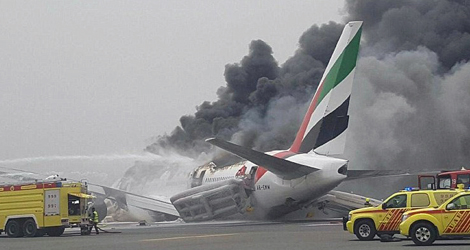 An aviation accident is an incident in which an aircraft is damaged or destroyed as a result of a collision, fire, structural failure, or other event. Aviation accidents can be caused by a variety of factors, including mechanical failure, pilot error, adverse weather conditions, and sabotage. Aviation accidents can result in fatalities, injuries, and damage to property.
An aviation accident is an incident in which an aircraft is damaged or destroyed as a result of a collision, fire, structural failure, or other event. Aviation accidents can be caused by a variety of factors, including mechanical failure, pilot error, adverse weather conditions, and sabotage. Aviation accidents can result in fatalities, injuries, and damage to property.
Aviation incidents
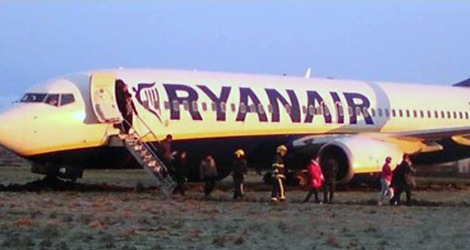 An aviation incident is an occurrence, other than an accident, that affects or could affect the safety of aircraft operations. Examples of aviation incidents include near collisions, runway incursions, and unruly passenger incidents.
An aviation incident is an occurrence, other than an accident, that affects or could affect the safety of aircraft operations. Examples of aviation incidents include near collisions, runway incursions, and unruly passenger incidents.
Aviation serious incidents
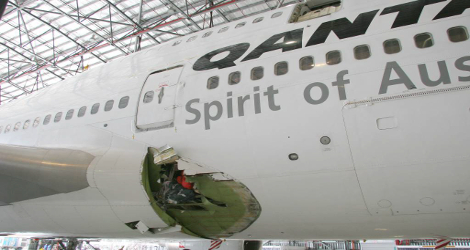
A serious incident in aviation refers to an event that could have resulted in an accident or that had the potential to cause serious injury or death. Some examples of serious incidents in aviation include engine failure, in-flight fires, and loss of control of the aircraft.

